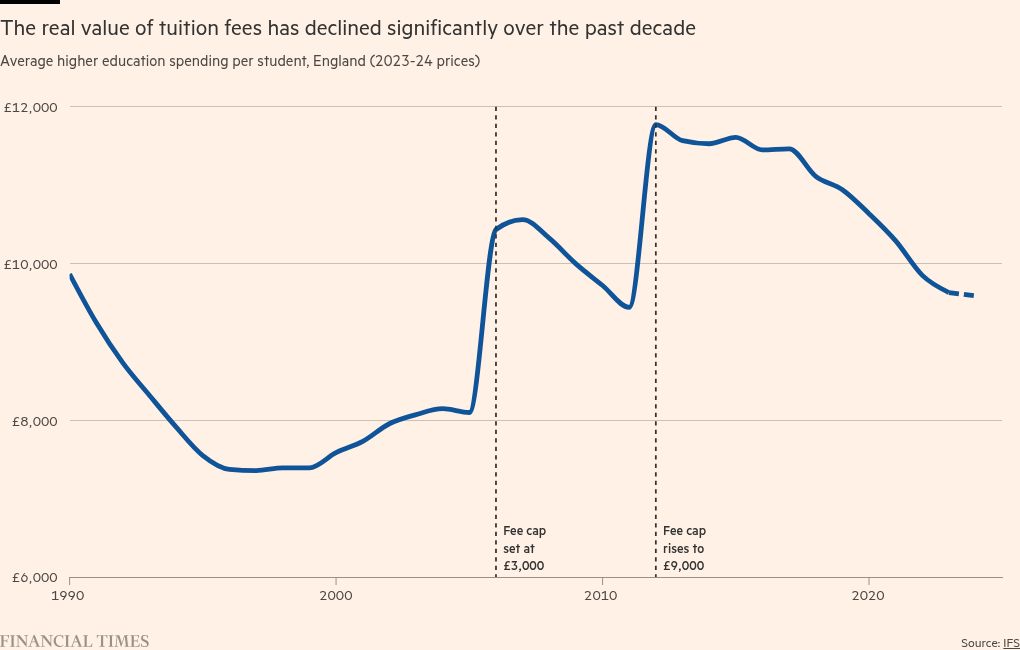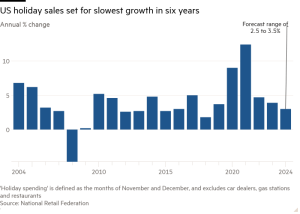What England’s tuition fee rise means for student and university finances

Unlock the Editor’s Digest for free
Roula Khalaf, Editor of the FT, selects her favourite stories in this weekly newsletter.
The Labour government has announced this week that university tuition fees and maintenance loans for England will increase in line with inflation next year — the first increase since 2017.
The move comes after growing warnings from university leaders that the higher education sector’s finances are becoming unsustainable while student groups warn that the mounting debt load is deterring students from less well-off backgrounds.
How much will the fees rise?
The £9,250 tuition fee paid by domestic students in England will increase to £9,535 for the 2025-26 academic year — an increase of £285.
In cash terms, this means fees have only increased by £535 since the £9,000 fee was introduced in 2012, while in real terms the value of fees has been steadily eroded by inflation, putting pressure on university finances.
The government also increased the maintenance loans that students can take out for their cost of living expenses by the same 3.1 per cent. This means a student living at home can borrow an extra £267 a year, while one living away from home in London can borrow an extra £414.
The government has not, however, reinstated maintenance grants for the poorest students.
What does this mean for student loan repayments?
In practical terms, not a lot. This is because, as education secretary Bridget Phillipson was at pains to point out when making the announcement on Monday, loan repayments are based on a percentage of a graduate’s salary, not the size of their outstanding loan balance.
So while this change will increase the total amount of debt that a student accrues, they will repay at the same fixed proportion of their salaries — 9 per cent of their income above a repayment threshold at present set at £25,000.
A graduate who took out loans from 2023 onwards will still pay £22 a month on earnings of £28,000 a year, or £60 a month on earnings of £33,000, according to examples provided by the UK government. Loans are automatically written off after 40 years.
Will this fix university finances?
Not really. Universities are warning that they face a looming financial crunch caused in part by the virtual freeze in tuition fees since 2000 and a sharp drop-off in more lucrative international students whose higher fees were helping to balance the books.
Calculations by the Russell Group estimated that, before the increase, universities were making a “loss” of £2,500 on each domestic student.
The Institute for Fiscal Studies (IFS) calculates that the tuition fee increase will raise £390mn a year for universities. However, changes to employers’ national insurance announced at the Budget will cost universities £372mn a year, according to analysis by the Universities & Colleges Employers Association, leaving a net gain of just £18mn.
University leaders welcomed the announcement as a “good start”, but Nick Hillman, director of the Higher Education Policy Institute (HEPI), said the net increase, which amounted to £45,000 per institution, or one new member of staff, “was at risk of being oversold”.
How much difference will this make for poorer students?
Not much. The IFS calculates that when rising prices are taken into account, the increase in maintenance loans of up to £414 a year amounts to a real-terms increase of just 1.6 per cent.
This does “little to reverse” real-terms cuts to the generosity of the maintenance system since 2020-21, the think-tank added.
Analysis published by HEPI last year warned of a “cost of learning crisis” as loans for maintenance were not covering the living costs of students from poor backgrounds who did not receive additional financial support from their parents.
The British Medical Association has warned that the headline increase in tuition fees will deter young people from opting for medical degrees at a time when the government faces a chronic shortage of doctors.
Rob Tucker, chair of the BMA’s Medical Students Committee, said the move would lift total student debt for medical degrees above £100,000 in many cases and “introduce yet another barrier” to students from disadvantaged backgrounds joining the medical profession.
Are there more fee raises to come?
Phillipson said on Monday that the fee increases were just a “first step” and that more needed to be done to support the sector and ensure that students from more disadvantaged backgrounds were not laden with outsized levels of debt.
“I wouldn’t say for one moment that this is the end in terms of what’s required, but it was a necessary step to make sure that our universities are put on a more sustainable footing,” she told LBC.
Government officials have been careful to note that the new policy only stipulates an inflation rise for 2025-26, and not subsequent years, with further detail on reform due next year.
According to the IFS, if the government continues to increase fees in line with the RPIX inflation measure each year, the tuition fee cap could reach £10,680 in 2029-30.
#Englands #tuition #fee #rise #means #student #university #finances








